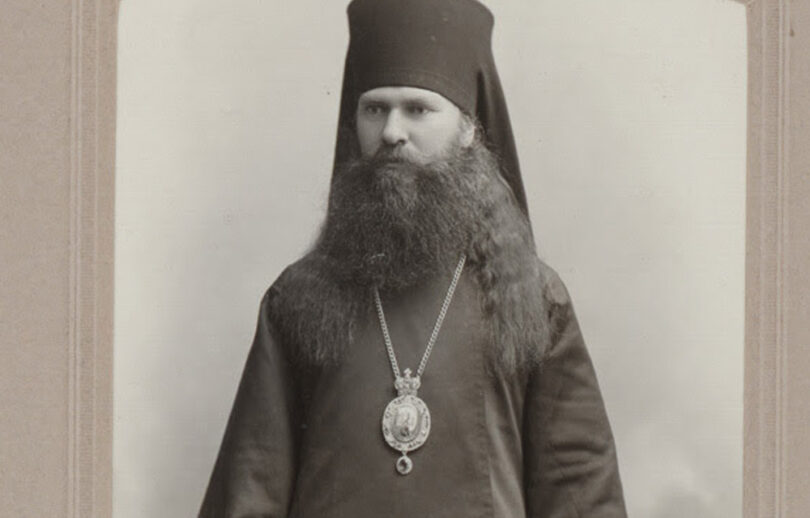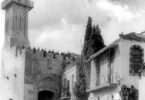Archbishop Sergii (Petrov) passed away on this day in 1935.
Stepan Alekseevich Petrov was born in the Don Cossack stanitsa (village) of Aksai on January 30, 1864. The future Archbishop Sergii’s parents were both pious Orthodox Christians and imbued their son with a deep and abiding respect for the Church and, most especially, the clergy. Aleksei Petrov, the future Archbishop Sergii’s father, as well as his grandfather, served as a prichetnik (a member of the lesser clergy and church services).
Stepan Alekseevich Petrov, the future Archbishop Sergii, graduated from the newly founded Don Theological Seminary in 1886, which restored the tradition of clerical education in the Diocese of Don and Novocherkassk. Despite the best hopes of the founders of the Don Seminary, and the youthful desire to follow his relatives into monasticism, Stepan Alekseevich Petrov, while at the Seminary, suffered a “spiritual malaise” and a “mental oppression” that threatened to make him abandon all thoughts of service to the Church.
As a sort of last hope to overcome these difficulties, Stepan Alekseevich decided to move to Tomsk, where his uncle, a former Archimandrite of the Altai Mission, was Bishop Vladimir (Petrov) of Tomsk and Semipalatinsk, and placed himself under his uncle’s guidance. There, he was impressed by the missionaries of the Altai Mission. He then enrolled in the Historical-Philological Faculty of Moscow University (the study of historical and comparative linguistics, in preparation for work in the Altai Mission), from which he graduated in 1890 with a diploma of the 1st Degree.
After his graduation from Moscow University, he attended lectures at the Kazan Theological Academy for further preparation to serve the Altai Mission. He also finally decided to embrace monasticism, and joined the Mission. In 1892, he was tonsured a monk with the name “Sergii,” and on November 7 of that year, ordained Hieromonk, and appointed as Assistant Director of the Kirghiz Mission (a “department” of the Altai Mission). By the time that the newly ordained Hieromonk Sergii (Petrov) was serving in the Altai Mission, the Mission already had a long and illustrious history. Founded in 1830, the Altai Spiritual Mission was the most famous, and most successful missionary effort of the Russian Orthodox Church in the 19th century. At the Irkutsk Missionary Congress of 1910, the Altai Mission was recognized as a “model and leader” for all other missions. In less than a century, from 1820 to 1910, more than half of the indigenous peoples of the Altai were drawn from paganism to Orthodoxy.
Hieromonk Sergii (Petrov) labored with the Altai Mission for 11 years; from the above, it can be assumed that those 11 years were possibly the happiest, as well as most rewarding of his life, but also a most difficult life, filled with hardships, deprivations, and dangers. In 1899, Hieromonk Sergii was appointed Director of the Altai Mission, and also called to Hierarchical Service, and was consecrated as Bishop of Biisk, Vicar of the Diocese of Tomsk Diocese. The Bishops of Biisk were also the Directors of the Altai Mission – during his tenure as Bishop of Biisk, Bishop Sergii concurrently served as Director of the Altai Mission.
As was the usual practice in the Russian Church at the time, Bishop Sergii did not remain as Bishop of Biisk for long. In 1901, he was appointed Bishop of Omsk and Semipalatinsk; 1903, Bishop of Kovensk, Vicar of the Litovsk Diocese; 1907, Bishop of Novomirgorod, Vicar of the Kherson Diocese; 1913, Bishop of Sukhumi, and thereafter Bishop of Chernomorsk and Novorosiissk. The latter would notably serve as an evacuation point for White Russians fleeing the Red Army’s advance. Bishop Sergii was a participant in the All Russian Council held in Moscow in 1917–1918, and also the Southeast Russian Church Council in Stavropol, May 19–24, 1919. In 1920, he was evacuated from Russia and went first to Constantinople and thereafter to Yugoslavia, where he participated in the Karlovci Council of 1921, which established the ROCOR. During his time in Yugoslavia, the ROCOR elevated him to Archbishop. He assisted with the administration of the ROCOR but soon went to live in the Serbian Monastery Privina Glava in the Fruška Gora mountains in northern Serbia.
Always suffering rather poor health, from the autumn of 1934, Archbishop Sergii noticeably declined. After the Nativity of the Lord, 1934, he never left the monastery enclosure. Only two days before his death, Archbishop Sergii bean to feel better. He made plans for the future days, read an article in Tserkovnaia zhiznʹ by Archbishop Anastassy of Kishinev, and fell to recollections – of his parents, his mother, who he lost at a young age, Aksai stanitsa, the Don, the endless expanse of the blue steppe, the miles of meadows covered in floods… The morning of January 11/24, 1935, found Archbishop Sergii cheerful, and in a rather loud voice, reading verses by Count Alexei Tolstoi. A short while later, a monk found him dead.
Michael Woerl (d. 2019)
Source:
Archbishop Sergii (Petrov, d. January 1935) of Chernomorsk and Novorossiisk, Historical Studies of the Russian Church Abroad.











